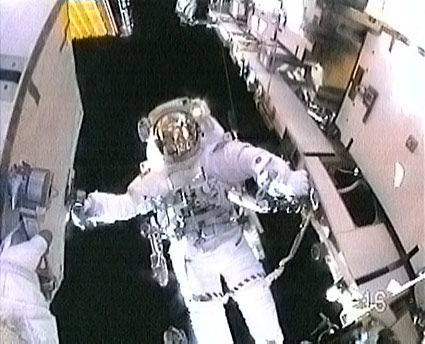With Spacesuit Glitches, NASA Takes No Chances

When anunexpected glitch pops up in an astronaut?s spacesuit during a spacewalk, NASAtakes no chances. If it looks like a problem, it?s time to call it quits.
Such was thecase Wednesday, when flight controllers at NASA?s Mission Control in Houstonordered two astronauts working outside the International Space Station to cuttheir spacewalk short after detecting rising levels of carbon dioxide inone of their spacesuits. The move was just a precaution - at no point was theastronaut in danger - but it provided a glimpse into how NASA treats spacesuitmalfunctions in the middle of a spacewalk.
?Aspacesuit is a very small spacecraft and there?s just really not much marginfor error,? NASA?s lead space station flight director Holly Ridings toldreporters late Wednesday.
The glitchoccurred inside astronaut Chris Cassidy?s spacesuit while he and fellowspacewalker Dave Wolf were replacing old solar array batteries on theInternational Space Station. The canister used to scrub carbon dioxide from theatmosphere inside Cassidy?s suit apparently wasn?t doing its job right, NASAofficials said.
?There is ateam meeting to discuss exactly what the signature was that caused the carbondioxide to trend upward near the end of the spacewalk,? said Kieth Johnson,NASA?s lead spacewalk officer for the space shuttle Endeavour?s currentmission to the station.
Spacewalksafety
NASAmeasures the amount of carbon dioxide in a spacecraft using millimeters ofmercury. For example, the acceptable limit for space shuttle and the spacestation is about 5 millimeters of mercury, Johnson said. The typical range fora spacewalking astronaut is between 0.3 and 0.5 millimeters of mercury, he added.
Breaking space news, the latest updates on rocket launches, skywatching events and more!
At itsworst, the carbon dioxide level in Cassidy peaked at about 3 millimeters ofmercury, well below the accepted threshold for the shuttle and nowhere near the8 millimeter mark that would have set off an alarm in his spacesuit warning ofan impending problem, mission managers said.
It is onlywhen levels reach 15 millimeters of mercury that astronauts would begin to feelthe effects of carbon dioxide poisoning, known as hypercapnia, Johnson said.
?It?s anuncomfortable situation. A crewmember would start feeling warm and a bit of airhunger,? Johnson said. ?In part of our training, we allow the crewmember toexperience that elevated [carbon dioxide] to know just exactly that it is acondition that they?re experiencing, and how to react to it.?
If thatever occurred, spacewalking astronauts could refer to an emergency procedure ina checklist attached to their spacesuit gloves, Johnson said. It lists exactlywhat to do in order to return to the airlock in the event of spiking carbondioxide levels, he added.
But NASA?snominal plan is to always return astronauts to the safety of the airlock beforerising carbon dioxide levels can become a problem. That?s why Mission Controlordered Cassidy and Wolf back insidethe space station a half hour earlier than planned.
Cassidylater told his crewmates and a flight surgeon in Mission Control that he feltfine and never experienced any symptoms related to carbon dioxide poisoning,mission managers said.
Theslightly elevated levels detected in Cassidy?s spacesuit were on an upwardtrend, possibly because the lithium hydroxide canister used to scrub carbondioxide from the suit?s atmosphere dried out early in the spacewalk or stoppedletting air flow through it properly, Johnson said.
A newcanister will be loaded into Cassidy?s spacesuit for his next spacewalk onFriday. Endeavour?s seven-astronaut crew is in the middle of a 16-day missionto deliver a new crewmember, spare parts and a Japaneseexperiment porch to the space station.
Wednesday?sspacewalk was the third of five planned for the mission. Endeavour launchedtoward the space station last week and is due to return to Earth July 31.
Theproblematic canister behind Wednesday?s shortened spacewalk will be returned toEarth for analysis when Endeavour lands.
?The teamis evaluating what happened and how it might affect the next couple of[spacewalks] that we?re doing, and we?ll just go from there,? Johnson said.
- Video - Almost Done: The International Space Station
- Image Gallery - Shuttle Endeavour Blasts Off at Night
- SPACE.com Video Show - ISS: Foothold on Forever
SPACE.comis providing continuous coverage of STS-127 with reporter Clara Moskowitz andsenior editor Tariq Malik in New York. Click here for missionupdates and SPACE.com's live NASA TV video feed.

Tariq is the award-winning Editor-in-Chief of Space.com and joined the team in 2001. He covers human spaceflight, as well as skywatching and entertainment. He became Space.com's Editor-in-Chief in 2019. Before joining Space.com, Tariq was a staff reporter for The Los Angeles Times covering education and city beats in La Habra, Fullerton and Huntington Beach. He's a recipient of the 2022 Harry Kolcum Award for excellence in space reporting and the 2025 Space Pioneer Award from the National Space Society. He is an Eagle Scout and Space Camp alum with journalism degrees from the USC and NYU. You can find Tariq at Space.com and as the co-host to the This Week In Space podcast on the TWiT network. To see his latest project, you can follow Tariq on Twitter @tariqjmalik.
